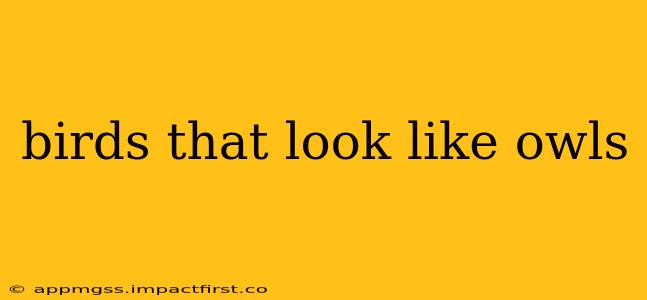Owls are undeniably captivating birds, with their large, forward-facing eyes and silent flight. But several other bird species share similar characteristics, leading to frequent confusion. This guide explores birds often mistaken for owls, highlighting their key features and differences. Understanding these distinctions will help you become a more astute birdwatcher and appreciate the incredible diversity of avian life.
What Birds Are Often Mistaken for Owls?
Many birds share physical traits with owls, particularly their size, plumage, and nocturnal habits. Some of the most common birds mistaken for owls include:
- Large, nocturnal birds of prey: Certain hawks and eagles, especially those active at dusk and dawn, might be confused with owls due to their size and silhouette.
- Birds with similar plumage: Some birds possess plumage patterns that mimic the mottled coloration of owls, providing effective camouflage.
- Birds with similar body shapes: Several species share a round body shape and relatively large head, leading to visual similarities with owls.
What are the Key Differences Between Owls and Other Birds?
While some birds might superficially resemble owls, key differences distinguish them:
- Facial Disks: Owls possess prominent facial disks – the circular arrangement of feathers around their eyes. While some birds might have slightly similar feather patterns, the distinct facial disk is a key owl characteristic.
- Eye Position: Owls’ eyes are positioned forward, granting excellent binocular vision, crucial for hunting. Most other birds have eyes positioned more laterally on their heads.
- Flight: Owls are known for their silent flight, due to specialized feather structures. Many other birds make more noise during flight.
- Hunting Style: Owls are primarily nocturnal hunters, using their exceptional hearing and vision to locate prey in low-light conditions. Many other birds are diurnal (daytime) hunters or have different hunting strategies.
Which Birds Specifically Look Like Owls?
Let's delve into specific bird species frequently mistaken for owls:
1. Great Horned Owl vs. Hawk Owls
Great Horned Owls are large, powerful owls with distinctive ear tufts (which are not actually ears). Hawk Owls, despite their name, are actually owls, but they have a more slender body shape and longer wings than many typical owls. The confusion arises from their similarly mottled plumage and hunting habits. The key difference often lies in their size and overall body proportions. Hawk owls tend to be more slender and less bulky than Great Horned Owls.
2. Nightjars vs. Owls
Nightjars are crepuscular (active at dawn and dusk) birds with large eyes and mottled plumage for camouflage. Their nocturnal habits and cryptic coloration often lead to mistaken identity. However, nightjars are significantly smaller than most owls and lack the prominent facial disk.
3. Eagle Owls vs. Other Large Birds of Prey
Eagle Owls, the largest owl species in many regions, can be confused with large hawks or eagles, particularly from a distance. However, eagle owls possess the characteristic owl facial disk and their flight pattern differs from that of other raptors.
How Can I Tell the Difference Between an Owl and a Similar-Looking Bird?
Careful observation is crucial for accurate identification. Consider the following:
- Size and Shape: Compare the bird's overall size and body proportions to known owl species in your region.
- Plumage: Examine the feather patterns and coloration for distinct features.
- Head Features: Look for the presence or absence of a facial disk and ear tufts.
- Eye Position: Note the position of the eyes on the head.
- Behavior: Observe the bird's activity patterns (nocturnal or diurnal) and hunting style.
Using binoculars and field guides will significantly enhance your ability to distinguish owls from other similar-looking birds.
Are there any other birds that might resemble owls?
While the aforementioned are most commonly confused with owls, several other birds, depending on location and perspective, could share superficial similarities. This includes some larger species of flycatchers, certain types of woodpeckers (especially at night), and even some larger songbirds at dusk. The key is to focus on the defining features described above.
By carefully examining these key distinctions and practicing your birdwatching skills, you'll soon become an expert at identifying owls and appreciating the unique characteristics of other, similar-looking birds.
